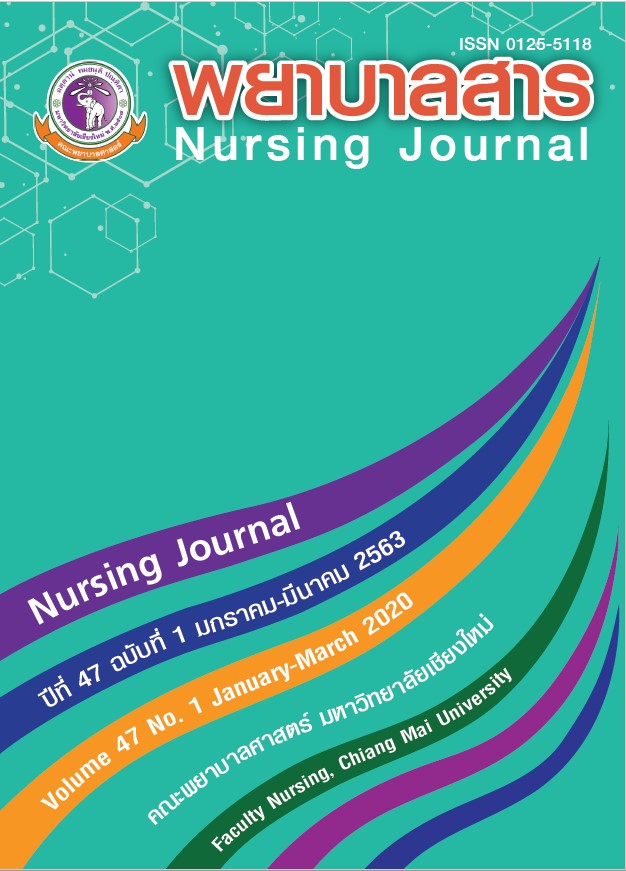Perceived Patient Safety Management Among Nursing Personnel in Fort Surasakmontri Hospital, Lampang Province
Keywords:
patient safety management, patient safety culture, Nursing Personnel, Surasakmontri HospitalAbstract
Patients expect safe care during hospitalization. Accordingly, patient safety management is a basic patient right and a major duty of hospital employees. This descriptive study was to examine overall patient safety management as perceived by nursing personnel in Fort Surasakmontri Hospital, Lampang Province and to explore the differences in perceived patient safety management among registered nurses, practical nurses and nurse aides. The study sample includes 26 registered nurses, 37 practical nurses and 40 nurse aides, all of whomhave had experience in nursing for at least one year in Fort Surasakmontri Hospital. The sampling techniques were stratified random sampling. The study instrument was a questionnaire which was developed based on the conceptual framework of the National Patient Safety Agency (2004). The content validity index was 0.94 and the reliability was 0.93. Data were analyzed using descriptive statistics and One Way ANOVA.
The study results were as follows:
- The overall of the perceived patient safety management among nursing personnel was at a high level (=3.22, S.D.=0.39). Patient safety management consisted of seven steps. Results illustrated that nursing personnel perceived the steps of building a safety culture, leading and supporting staff, integrating risk management activity, promoting incident report, involving and communicating with patients and the public, learning and sharing safety lessons and implementing solutions to prevent harm were at the high level (=3.39, S.D.=0.38; =3.25, S.D.=0.39; =3.31, S.D.=0.43; =3.19, S.D.=0.50; =3.16, S.D.=0.48; =3.10, S.D.=0.56; and =3.15, S.D.=0.46 respectively).
- There was no statistical difference in the overall of the perceived patient safety management among registered nurses, practical nurses and nurse aides. However, there were statistical differences in perception of registered nurses and non-registered nurses regarding the steps of promoting incident report (F = 4.623, p<0.05) and involving and communicating with patients and the public (F = 6.844, p<0.05).
The results of this study could contribute nurse managers and hospital administrators to understanding the progress of patient safety management in Fort Surasakmontri Hospital. It was recommended that nurse managers and hospital administrators should regularly measure performance in patient safety management in order to ensure that the care provided is as safe as possible for patients.
References
Boonnun, J., & Chayaput, P. (2009). Nurse’s role in unfavorabl e information “breaking bad news”communication to cancer patients. Thai Journal of Nursing Council 2009, 24(3), 7-19. (In Thai)
Burns, N., & Grove, S. K. (1997). The practice of nursing research: Conduct, critique & utilization.(3rd ed). Philadelphia: W.B. Saunders.
Chaleoykitti, S., Kamprow, P., & Promdet, S. (2014). Patient safety and quality of nursing service. Journal of The Royal Thai Army Nurses, 15 (2), 66-70. (In Thai)
Fort Surasakmontri Hospital. (2014). Self Assessment Report SAR 2014. Lampang: Quality of Fort Surasakmontri Hospital. (In Thai)
Khunthar, A. (2014). The impacts and solutions to nursing work force shortage in Thailand. Journal of Nursing Science, 32(1), 81-90. (In Thai)
Makary, M. A., & Daniel, M. (2016). Medical error the third leading cause of death in the US.British Medical Journal, 353(i2139), 1-5.
Mayo, A. M., & Duncan, D. (2004). Nurse perceptions of medication errors: What we need toknow for patient safety. Journal of Nursing Care Quality, 19 (3), 209-217.
National Patient Safety Agency (NPSA). (2004). Seven steps to patient safety. The full reference guide. National patient safety agency. Retrieved from http://www.npsa.nhs.uk/seven steps.
Nowneow, P. (2007). The relationships Between the Effectiveness of Safety Management in Nursing Care Delivery System and Patient Safety at Community Hospitals in NakhonSawan Provinc e (Master’s thesis, Sukhothai Thammathirat Open University). (I n Thai)
Nursing organization of Fort Surasakmontri Hospital. (2016). Self Assessment Report SAR 2016. Lampang: Quality of Fort Surasakmontri Hospital. (In Thai)
Padungsak, S. (2009). Nurse’s perception on patient safety culture and incidence of adverse events in Northern Regional Hospitals (Master’s thesis, Chiang Mai University). (In Thai)
Risk Management Department of Fort Surasakmontri Hospital. ( 2014). Risk Management Policy 2014. Lampang: Fort Surasakmontri Hospital. (In Thai)
Risk Management Department of Fort Surasakmontri Hospital. ( 2016). Risk Management Policy 2016. Lampang: Fort Surasakmontri Hospital. (In Thai)
Srisatitnarakul, B. (2007). The methodology in nursing research (4 th ed.). Bangkok: U&I Intermedia.(In Thai)
Suphachutikul, A. (2008). Thai patient safety goals: SIMPLE. Bangkok: Paramartha. (In Thai)
Tansirisithikul, R., Wannasil, N., Theppang, K., Limpanylert, P., & Winyawat, C. (2012). Knowledge review report developing a patient safety system. Retrieved from https://www.shi.or.th. (In Thai)
The Joint Commission on Accreditation of Healthcare Organizatio ns. (2008). JCI Accreditation Standards for Hospitals (3 rd ed.). Retrieved from http://www.jointcommissioninternational.org/Programs-Hospitals/
Wolf, Z.R., & Serembus, J.F. (2004). Medication error: ending the blame-game. Nursing management, 35(8), 41-2,44,47-8.
World Health Organization. (2006). The Conceptual Framework for the International Classification for Patient Safety (ICPS). Retrieved from https://www.who.int/patientsafety/implementation/taxonomy/ICPSreport/en/#:~:text=Overview,The%20C onceptual%20Framework%20for%20the%20International%20Classification%20for%20Patient%20Safety,improving%20patient%20safety%20across%20systems.
Downloads
Published
How to Cite
Issue
Section
License
บทความที่ได้รับการตีพิมพ์เป็นลิขสิทธิ์ของวารสารพยาบาลสาร
ข้อความที่ปรากฏในบทความแต่ละเรื่องในวารสารวิชาการเล่มนี้เป็นความคิดเห็นส่วนตัวของผู้เขียนแต่ละท่านไม่เกี่ยวข้องกับมหาวิทยาลัยเชียงใหม่ และคณาจารย์ท่านอื่นๆในมหาวิทยาลัยฯ แต่อย่างใด ความรับผิดชอบองค์ประกอบทั้งหมดของบทความแต่ละเรื่องเป็นของผู้เขียนแต่ละท่าน หากมีความผิดพลาดใด ๆ ผู้เขียนแต่ละท่านจะรับผิดชอบบทความของตนเองแต่ผู้เดียว






